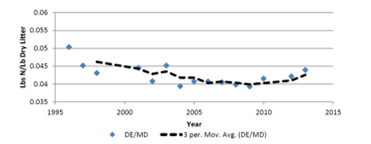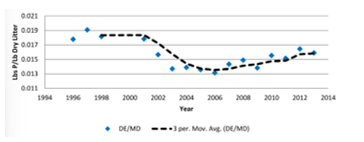
Fact Sheets And Publications
Maximizing the Potential of Poultry Litter as a Valuable Nutrient Source for Sustainable Crop Production
May 2025 | Written by Sapana Pokhrel and Amy Shober
Background
The Delmarva Peninsula stands out as a prominent hub for broiler production, accounting for production of nearly 600 million broilers annually (Delaware Chicken Association, 2023). In 2022, Delaware raised approximately 234 million broilers, with a production value of 1.53 billion U.S. dollars (USDA NASS, 2023). The presence of a robust broiler industry on the Delmarva Peninsula also necessitates the management of poultry litter (i.e., a composite of bedding material, feed, manure, feathers, and uric acid) in an environmentally responsible manner. Litter production is estimated between 2.3 to 3 lb of litter per bird, with the low end of the range for a bird with a 5 lb average market weight and the high end for a 9.5 lb average market weight bird (USDA, 2024). As such, total annual litter production on the Delmarva is estimated to be upwards of 685 thousand tons.
Despite sometimes being regarded as a waste product, poultry litter holds significant value for Delmarva farmers as a source of essential plant nutrients when applied to soils to fertilize crops like corn, soybean, small grains, or pasture grasses. Yet, the historical practice of applying poultry litter to croplands near poultry operations has led to the accumulation of phosphorus (P) in agricultural soils. This localized soil P enrichment has been linked to regional water quality degradation. While land application remains the most desirable use for poultry litter, the environmental reality is that litter must often be moved farther from the source so that it can be applied to agricultural lands that can benefit from P application. To address environmental concerns, all three states in the Delmarva region have taken initiatives cost-sharing programs aimed at mitigating the impact of poultry litter on the Chesapeake Bay watershed. These cost-share efforts aim to make poultry litter accessible to farmers in a wider geographical region or to move litter out of the Chesapeake Bay watershed to alternative uses (e.g., exportation to the mushroom industry). The primary goal of this publication is to quantify the value of poultry litter as a fertilizer.
Benefits of Poultry Litter as a Fertilizer
Fertilizer accounts for a substantial portion of input costs for crop production, accounting for approximately 30 to 40% of input costs to crops with a high nitrogen (N) requirement (i.e., corn). Poultry litter can offer a local, cost-effective alternative to commercial fertilizers, especially during periods of elevated fertilizer prices or shortages. Poultry litter contains primary macronutrients (i.e., N, P, and potassium [K]), as well as secondary macronutrients, micronutrients, and organic matter. As such, the use of poultry litter as a nutrient source can be beneficial to crop production and soil health, extending beyond what commercial fertilizers alone provide. These attributes make poultry litter an appealing choice for sustainable and economical agricultural practices in the Delmarva region.
Local nutrient source: Poultry litter is often generated locally on the Delmarva Peninsula, which reduces the environmental impact (i.e., carbon footprint) of crop production by diminishing the need for extensive manufacturing and transportation associated with commercial fertilizers to support crop growth.
Gradual N release: The slow-release nature of poultry litter N helps to reduce the potential for early-season N leaching and helps feed the crop over time. Approximately 30-80% of the N in poultry litter is in an organic form (i.e., associated with carbon; Zhang et al., 2017). Organic N is gradually converted to plant available N forms (i.e., mineralized) throughout the growing season as carbon is broken down during microbial activity.
Secondary macronutrient and micronutrient source: Poultry litter contains sulfur (S), a secondary macronutrient whose demand has increased due to a significant decrease in atmospheric S deposition. Each ton of poultry litter can contribute 9 to 15 lb of S (Hergert, 2015; Gaskin et al., 2013). Additionally, poultry litter contains micronutrients like manganese (Mn), boron (B), zinc (Zn), and copper (Cu). By incorporating poultry litter into the soil, farmers can supply these vital nutrients to their crops without the need for additional (and often more costly) commercial fertilizers containing micronutrients.
Soil improvement: Poultry litter contains a significant amount of organic matter. Over time, land application of poultry litter can increase soil organic matter content and improve soil aggregation, leading to better air and water movement through the soil. Poultry litter also contains beneficial microbes and promotes soil microbial activity that facilitates nutrient cycling processes in soils and improves plant nutrient uptake.
Factors Influencing the Nutrient Content of Poultry Litter
The nutrient content of poultry litter is variable due to a variety of factors including bird genetics, diet formulations, and in-house management practices. Laboratory analysis of poultry litter generated in Delaware and Maryland (Agricultural Modeling Subcommittee, 2015) from the mid-1990s through 2015 show temporal trends in litter in the N and P content (Figures 1 and 2).
Improved ventilation in poultry houses has helped growers better maintain optimum temperature, enhance air circulation, and control moisture levels, which has resulted in heavier birds with improved feed conversion rates and reduced mortality. However, this increased ventilation may also lead to increased ammonia volatilization, potentially contributing to the observed decrease in litter N content from 1996 to 2005 (Figure 1). To address the challenge of in-house ammonium volatilization, litter additives such as poultry litter treatment (PLT) and alum gained popularity in the poultry industry. These additives acidify litter, thereby reducing ammonia volatilization within poultry houses while also minimizing pathogens, enhancing bird performance, and increasing N content in the litter. The use of litter amendments is a possible reason for the observed increase in N content in poultry litter after 2012 (Figure 1).

Figure 1. Trends in poultry litter N concentrations for litter produced during broiler production in Delaware and Maryland (Source: Agricultural Modeling Subcommittee).
Similarly, the poultry litter data show a clear downward trend in litter P concentrations from the mid-1990s to 2013, which was primarily attributed to changes in poultry genetics and alterations in feed formulations (i.e., the incorporation of phytase as a feed amendment and subsequent reduction in calcium phosphate additives; Figure 2). However, litter P concentrations began to increase again after 2015. Several factors likely contributed to the increase in P content, including an increase in the average market weight of broilers (i.e., more litter generated) or changes in litter management practices that increased the in-house litter residence time (e.g., increase in windrowing between flocks, less frequent whole house cleanouts).

Figure 2. Trends in poultry litter total P concentrations for litter produced during broiler production in Delaware and Maryland (Source: Agricultural Modeling Subcommittee).
Understanding and managing poultry nutrient litter variability is essential for farmers to optimize results. The fact that the nutrient content of poultry litter is influenced by various management factors underscores the importance of regular poultry litter analysis. While book values are available for determining poultry litter nutrient content and application rates, relying solely on these values may not provide the accurate representation due to the variability of litter properties. Conducting annual sampling and analysis of poultry litter prior to land application allows crop producers to fine tune application rates to improve on-farm nutrient management. Getting an accurate representation of litter nutrient content relies on proper sample collection, which will vary for litter that is sampled from stockpiles, manure storage structure, or inside the house. Detailed instructions for sampling poultry litter are available in Know the Value of Manure: Manure Sampling and Analysis (available at http://www.udel.edu/0013476). Delaware farmers can submit their poultry litter samples to the Delaware Department of Agriculture Agricultural Compliance Laboratory for complimentary testing. Other regional private analytical labs offer manure analysis for a nominal fee.
Summary
Despite the array of benefits poultry litter provides as a fertilizer source, its use is accompanied by several management challenges. Farmers interested in land-applying poultry litter will need to have access to equipment for spreading and potentially incorporating poultry litter. Application rates will need to be adjusted for year to year due to variability in nutrient content. In addition, farmers will need to manage applications to reduce odors and transmission of pathogens. Finally, farmers should be cognizant of potential soil acidification, nutrient imbalance, and the accumulation of heavy metals with repeated applications of poultry litter. However, despite these challenges, poultry litter is an asset for farmers in Delaware and throughout the Delmarva Peninsula, offering a cost-effective and nutrient-rich alternative to commercial fertilizer. The benefits of poultry litter land application extend beyond crop nourishment by positively impacting soil health and promoting sustainable agriculture practices. To manage poultry litter effectively, routine litter sampling and analysis is the key, ensuring both economic and environmental responsibility. By providing a steady supply of macro and micronutrients, as well as adding organic matter, poultry litter application supports sustainable crop production on the Delmarva Peninsula.
References
Agricultural Modeling Subcommittee. 2015. Poultry litter subcommittee report. https://www.chesapeake.org/stac/presentations/268_3A%20Terrestrial%20Inputs%20Appendices.pdf
Delmarva Chicken Production. 2023. Delmarva chicken production facts 1957-2022. https://www.dcachicken.com/facts/docs/Delmarva-Chicken-Production-Facts-1957-2022.pdf
Gaskin, J., G. Harris, A. Franzluebbers, and J. Andrae. 2017. Poultry litter as fertilizer. University of Georgia Extension.
Riggi S. Y., and A. L. Shober. 2023. Know the value of manure: Manure sampling and analysis. University of Delaware Cooperative Extension. https://www.udel.edu/academics/colleges/canr/cooperative-extension/fact-sheets/know-the-value-of-manure/
Ritz, C.W., and W.C. Merka. 2013. Maximizing poultry manure use through nutrient management planning. https://secure.caes.uga.edu/extension/publications/files/pdf/B%201245_3.PDF
USDA AMS. 2024. Broiler Market News Report. https://mymarketnews.ams.usda.gov/viewReport/3646
USDA NASS. 2023. Poultry production and value. https://downloads.usda.library.cornell.edu/usda-esmis/files/m039k491c/wm119387d/5138kw352/plva0423.pdf
Zhang, H., D.W. Hamilton, and J. Payne. 2017. Using poultry litter as fertilizer waste nutrient management specialist waste management specialist. Oklahoma State University Extension. http://osufacts.okstate.edu.
About the Authors
Sapana Pokhrel, Postdoctoral Researcher, University of Delaware, Newark, DE
Amy L. Shober (corresponding author), Professor and Extension Specialist, University of Delaware, Newark, DE
About the Publication
Original publication date: 2025
Peer Reviewers
Drew Harris, Extension Agent, University of Delaware Cooperative Extension, Dover, DE
Sydney Riggi, Extension Agent, University of Delaware Cooperative Extension, Dover, DE
